Isabella Bradford's Blog, page 33
June 29, 2017
Casual Friday: Victorian Jewellery at the Museum of London
Loretta reports from London:
Today's photos: some Victorian bling from the Museum of London . Below, in order:
gold tourmaline jewelry c. 1860, in original case; tiara front or comb mount c.1840; brooch and earrings c. 1850 (gold set with aquamarines, rubies, and foiled quartz). Unfortunately, I seem not to have collected correct info for the last item. Labeling in the museum is not very detailed, but you can contact them for more specifics, if you're curious.
I apologize for any confusion and lack of story in these posts: Blogger hates my iPad and vice versa. This combined with a dial-up internet connection makes posting an ordeal.
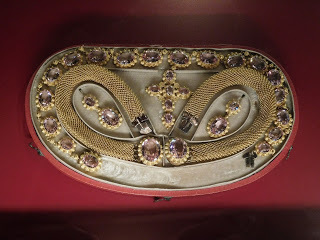
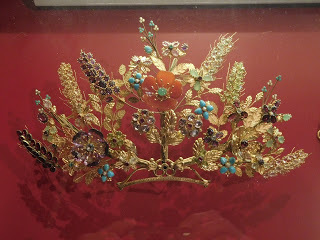
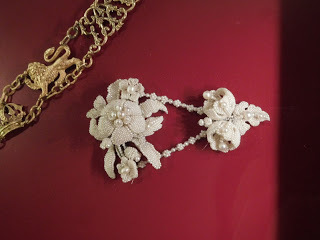
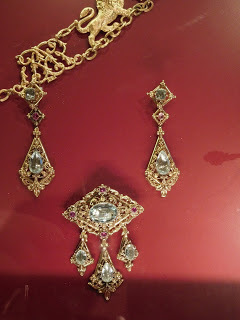
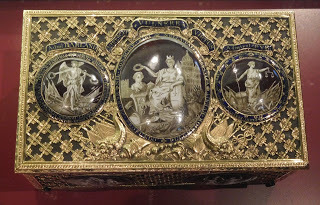
Please click on images to enlarge.
Today's photos: some Victorian bling from the Museum of London . Below, in order:
gold tourmaline jewelry c. 1860, in original case; tiara front or comb mount c.1840; brooch and earrings c. 1850 (gold set with aquamarines, rubies, and foiled quartz). Unfortunately, I seem not to have collected correct info for the last item. Labeling in the museum is not very detailed, but you can contact them for more specifics, if you're curious.
I apologize for any confusion and lack of story in these posts: Blogger hates my iPad and vice versa. This combined with a dial-up internet connection makes posting an ordeal.





Please click on images to enlarge.
Published on June 29, 2017 21:30
June 28, 2017
Looking Backwards & Forwards at History at Valley Forge
 Susan reporting,
Susan reporting,The perception of the historical past is always changing. Each new generation looks at history with fresh eyes, and fresh ideas, too.
Nowhere is this more evident than in how we Americans have treated our historically important buildings. In the years following the American Revolution, many of the place we now venerate most were simply old buildings, allowed to grow more shabby by the year.
Portions of Independence Hall in Philadelphia - the site of the signing of the Declaration of Independence - had already fallen into such disrepair that they were torn down in 1812. Federal Hall in New York City - home of the first Congress as well as where George Washington was inaugurated as the first president - was also demolished barely a generation later in 1812. Built in 1713, the Old State House in Boston witnessed the Boston Massacre, but was later cut up into shops and businesses, and finally suffered the ultimate indignity of having a subway station built into its basement.

But the Centennial celebrations of 1876 brought a new interest in preserving the past. Older buildings were finally beginning to be recognized and preserved for their historical importance. Sometimes, however, these early preservationists often relied on a romanticized version of the 18thc, with some interesting results.
The present-day Valley Forge National Historical Park in Pennsylvania first became recognized as a state park focused on history in 1893. Then, as now, the centerpiece of the park was the stone farm house used by General George Washington as his headquarters during the Continental Army's winter encampment of 1777-78. Also known as the Isaac Potts House for the original owner, the Headquarters was occupied not only General Washington, but by his wife Martha Washington, seven aides-de-camp, servants, and occasional visitors. The house is not large, especially not considering how many people were squeezed inside it, and from contemporary reports, quarters were cramped, and tempers often ran short.
But you'd never guess it from the way the house was decorated and presented to the public in the early 20thc. The photo, right, on display in the information center near the Headquarters, shows the parlor as a genteel, white-washed room decorated in the best Colonial Revival style, complete with a spinning wheel and yarn-winder for processing homespun fibers (no mention of whom was doing all that spinning.) The original caption declares it to be a view of the "parlor and secret passage." But as the modern caption in the information center dryly notes:
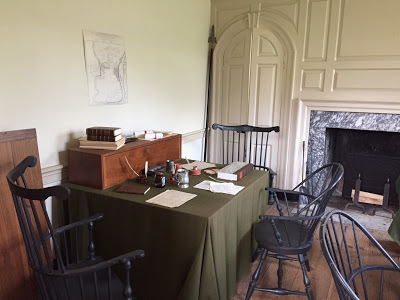
"When [the house] opened as a museum, explanations of the way the house had been used as a military headquarters were fanciful. The hallway identified here as a 'Secret Passage' was, in fact, an entrance used by those arriving by carriage in the 18thc."
Based on research, archeology, and paint-sampling, the same room is interpreted today, upper and lower left, as the busy hub of the military camp. There are chairs, tables, and desks strewn with letters, pens, and books, with charts and maps pinned to the walls. The white dishes on the shelves are reproductions of what was used in the house in 1777. It's a lively room, and has the distinct feeling that the occupants have only stepped out for a moment, soon to return. To 2017 eyes, it feels authentic.
But I wonder if those young officers stationed here in 1777 would agree. Would they feel at home in this modern recreation? Or would aspects of it appear as peculiar to them as the spinning wheel now does to us in the early 20thc picture? And I wonder, too, how this same room will be presented in 2117....
Middle photo: Valley Forge NHP.
Photos upper & lower left: ©2017 Susan Holloway Scott.
Published on June 28, 2017 21:00
June 26, 2017
Churchill War Rooms
Loretta reports from London:
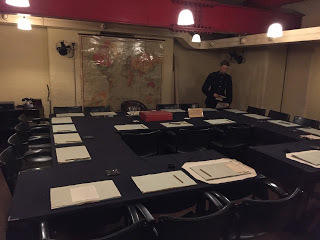 Fairly early on in our time in London, we visited the
Churchill War Rooms
. This happened a few days after the attack at London Bridge, and made perfectly clear, in case we hadn't already realized, what it really means to be a "city under siege." As in, when bombs are falling and invasion is a definite possibility.
Fairly early on in our time in London, we visited the
Churchill War Rooms
. This happened a few days after the attack at London Bridge, and made perfectly clear, in case we hadn't already realized, what it really means to be a "city under siege." As in, when bombs are falling and invasion is a definite possibility.
"The story of the Churchill War Rooms is ... one of brilliant improvisation in the face of deadly necessity," according to the guidebook. You can read a short history of its creation here, and learn more about it on the website. I'm going to do my usual while abroad with extremely low speed internet and alien computer technology, and offer pictures.
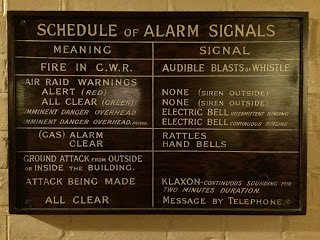 What I will point out is, not until you get down into this claustrophobic space, think about the numbers of people working here every day and night in secret, read the signs, see the working conditions, and so on, do you have the beginnings of a clue about what it might have been like to get through that war. I choked up more than once, thinking about the courage and endurance of these heroes.
What I will point out is, not until you get down into this claustrophobic space, think about the numbers of people working here every day and night in secret, read the signs, see the working conditions, and so on, do you have the beginnings of a clue about what it might have been like to get through that war. I choked up more than once, thinking about the courage and endurance of these heroes.
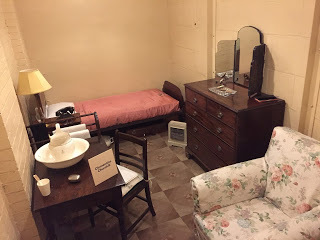
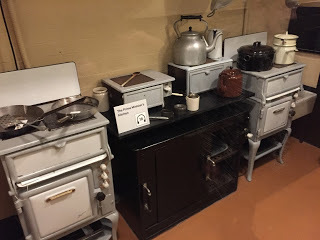
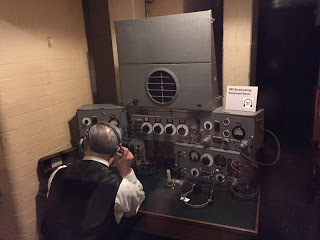
 Fairly early on in our time in London, we visited the
Churchill War Rooms
. This happened a few days after the attack at London Bridge, and made perfectly clear, in case we hadn't already realized, what it really means to be a "city under siege." As in, when bombs are falling and invasion is a definite possibility.
Fairly early on in our time in London, we visited the
Churchill War Rooms
. This happened a few days after the attack at London Bridge, and made perfectly clear, in case we hadn't already realized, what it really means to be a "city under siege." As in, when bombs are falling and invasion is a definite possibility."The story of the Churchill War Rooms is ... one of brilliant improvisation in the face of deadly necessity," according to the guidebook. You can read a short history of its creation here, and learn more about it on the website. I'm going to do my usual while abroad with extremely low speed internet and alien computer technology, and offer pictures.
 What I will point out is, not until you get down into this claustrophobic space, think about the numbers of people working here every day and night in secret, read the signs, see the working conditions, and so on, do you have the beginnings of a clue about what it might have been like to get through that war. I choked up more than once, thinking about the courage and endurance of these heroes.
What I will point out is, not until you get down into this claustrophobic space, think about the numbers of people working here every day and night in secret, read the signs, see the working conditions, and so on, do you have the beginnings of a clue about what it might have been like to get through that war. I choked up more than once, thinking about the courage and endurance of these heroes.


Published on June 26, 2017 21:30
June 25, 2017
What Story Is This 18thc Painting Telling?
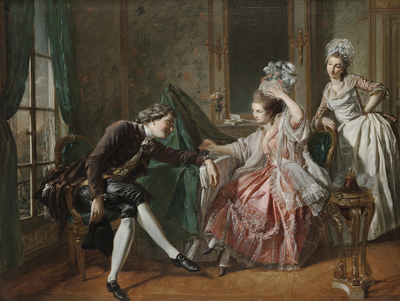 Susan reporting,
Susan reporting,Earlier in the year, I posted this painting on Instagram along with close-ups of various details. The painting is so intriguing that I'm going to assemble my rambling observations here as a blog post as well - please feel free to offer your own interpretations! (And, as always, click on the images to enlarge them.)
The artist is Louis Rolland Trinquesse (c1746-1800), a Frenchman who specialized in creating titillating scenes like this that his wealthy patrons craved. With that in mind, I doubt that the title the painting has now - An Elegant Interior with Two Ladies and a Gentleman - was what it was originally called. I'm sure it went by something much more suggestive and saucy; that's just the kind of picture it is.
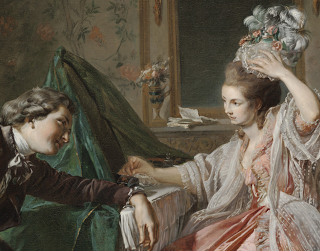
The gentleman is clearly a good "friend," and has been granted the intimacy of being here in the boudoir of the woman in pink while she dresses. We'll call her the mistress of the house, and I'd guess that she may be (or has been) his mistress as well. This could be an expensively appointed room in their love-nest, or it could be the house she shares with an absent husband. She's wearing a sheer white dressing robe to protect her gown as she arranges her hair and make-up - another sign of intimacy.
But while the man is doing his best to press his advantage - he's leaning into her, his foot nearly touches hers, and his hand is almost on her knee - the mistress doesn't seem entirely pleased that he's there. She's paying more attention to repairing her somewhat mussed hair and cap than to him. Her tiny feet it seductively high-heeled mules do point towards him, but her legs are firmly crossed at the knee.
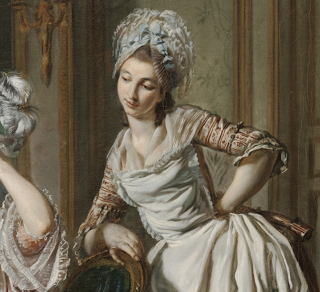
Meanwhile, the maidservant (and despite the painting's current title, she is definitely a servant from her dress) seems to be watching the other two with sly interest. She definitely Knows Things, and has probably Seen Things, too, and she'd be perfectly happy to tell them. Note how familiarly she's leaning on the back of her mistress's chair. She's probably wearing her cast-off clothing, as was a common practice among lady's maids, and her cap is nearly as impressive as the one her mistress is wearing. But the front of the maid's pinner apron seems loose, even rumpled, and without that flat, straight front that 18thc stays gave to every woman's torso. Has she left off her stays? Is her body uncorseted, and agreeable available beneath her gown? Maybe she's plotting to take her mistress's place in the man's attentions and his bed - or perhaps she already has.
Outside the window, the sun is either setting, or rising. Does it signify the beginning of an affair, or the end of it? Is the the aftermath of a nigh-long dalliance that the mistress is already regretting, or is she wrestling with her consciences, and wondering whether to give in to the man's persuasive seduction? Consider how she's holding that elaborate cap on her equally elaborate hair with one hand, while taking a pin from the pin cushion with the other (she would have used ordinary straight pins to anchor the cap to her hair.) Would she use one of those pins to jab his wrist if his hand creeps too close?

The fluttering pages of the open book in the background imply an unfinished story. It also appears as if the green drape around the mistress's looking glass on her dressing table has been pulled to cover the glass entirely. Is her conscience so unsettled that she doesn't want to confront her own reflection?
One final thing to note: the large incense burner (the peculiar item on the tripod stand int he foreground) is smoking: richly, luxuriantly, fragrantly. And where's there's smoke....
So what story do you see when you look at this painting?
Above: An Elegant Interior with Two Ladies and a Gentleman by Louise Rolland Trinquess, 1776, The Wadsworth Atheneum.
Published on June 25, 2017 17:42
June 24, 2017
Breakfast Links: Week of June 18, 2017
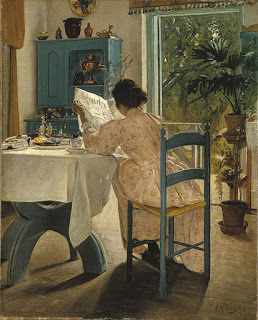 Breakfast Links are served - our weekly round-up of fav links to other web sites, articles, blogs, and images via Twitter.
Breakfast Links are served - our weekly round-up of fav links to other web sites, articles, blogs, and images via Twitter.• Kate Warne , the first female detective in the United States.
• Jane Austen , war novelist and worldly businesswoman.
• A rare deposition from the Salem Witch trials that helped sentence an elderly widow to death is to be sold.
• Image: Stunning 1856 photo of Queen Victoria with George III's daughter Princess Mary (Minnie.)
• Changes on the land: 19th American photography east of the Mississippi.
• An 18thc tartan frock coat that may have been worn by Bonnie Prince Charlie himself.
• How a fragment of Chinese wallpaper at Uppark can be a piece in a continent-wide puzzle.
• Image: An early 19thc view of Sadler's Wells Theatre.
• Spy techniques of the American Revolution.
• Protection and punishment: beliefs about angels in Tudor & Stuart England.
• The painted leg: liquid stockings of the 1940s.
• Mud, sweat, and fears: the making of a Japanese kimono .
• Architect Mary Colter was "a surly woman who cursed with abandon" - and designed pioneering National Park structures that blended into the environment.
• Striking portraits of ancient people in this collection of Fayum portraits .
• Image: Surely this "Mosco Silk" shawl was unusual in 1804 Portland, Maine.
• How Tories used money and influence to win an election ...in 1816.
• Rayon , an epidemic of insanity, and the woman who fought to expose it.
• The comforts of home on the battlefield: an 18thc folding camp bed used by General George Washington.
• Umbrella etiquette and manners in the 19thc.
• Remembering Bingo , a trench dog and mascot of World War One.
• Mary Katherine Goddard , the printer of the first broadside of the Declaration of Independence to list signers.
• Image: Just for fun: Civil status, according to Jane Austen . And while we're at it, how about these hints on achieving a Regency Beach Body .
Hungry for more? Follow us on Twitter @2nerdyhistgirls for fresh updates daily.
Above: At Breakfast by Laurits Andersen Ring. Private collection
Published on June 24, 2017 14:00
June 22, 2017
Friday Video: Behind the Scenes at the Costume Institute of the Metropolitan Museum of Art
Susan reporting,
Consider this both a Friday Video, and a super-duper Breakfast Links.
Recently Google launched a new project through their Arts & Culture program. Called "We Wear Culture: The Stories Behind What We Wear" - the landing-page link is here - the program features scores of links to videos, articles, and on-line exhibitions that highlight fashion, material culture, and clothing, both past and present. Links will lead to museums, collections, and institutions from all over the world, and cover everything from modern fashion trendsetters to the most ancient of textile crafts. There is so much to explore - be prepared to spend some time!
The video, above, is a taste of what you'll find. This is a short behind-the-scenes look at the Conservation Laboratory of the Metropolitan Museum of Art's Costume Institute, and features several garments that presented special challenges. A hint for viewing this video (and it took me a few tries to figure this out!): use the navigation tool in the upper corner to go right and reach each new segment. I remember seeing the Worth gown on display as part of last year's "Masterpieces" exhibition, and the solution to the gown's issues was wonderfully unobtrusive, and a sympathetic way to present a still-beautiful, if damaged, garment.
If you receive this post via email, you may be seeing an empty space or black box where the video should be. Click here to go directly to the video.
Published on June 22, 2017 21:00
June 21, 2017
The Wallace Collection
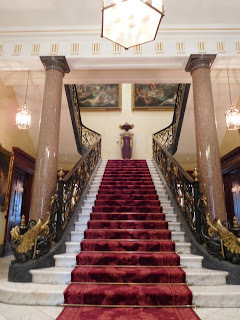 Loretta reports from London:
Loretta reports from London:Though I had already put the Wallace Collection on my list of must-sees, the enthusiasm of our guide on a Marylebone walking tour led us to seek it out sooner rather than later.
As we came through the entrance, I think my head snapped back, and I had an image of myself with my eyes popping out of my head like a cartoon character. I've been to quite a few stately homes and museums, but I must say that none quite matched the visual impact of this. Though no photos can fully capture the experience, these will, I hope, offer a sense of the house. I also urge you to explore the website.
Meanwhile, we have our fingers crossed that time and circumstances will allow us to go back before we have to leave London.
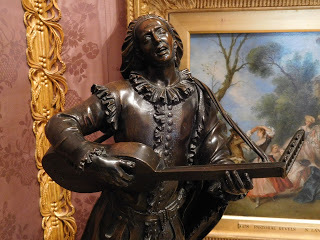
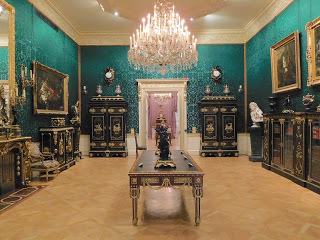


Published on June 21, 2017 21:30
June 19, 2017
When the Other Army Triumphs: The Benjamin Ring House & the Battle of Brandywine, 1777
 Susan reporting,
Susan reporting,Wars are fought by armies, soldiers, and generals, but too often civilians in the path of battles suffer, too.
Earlier this year I wrote about Gideon Gilpin , a Quaker farmer and his young family living near present-day Chadds Ford, PA. In 1777, the Gilpins found themselves in the middle of the Battle of Brandywine, the largest land battle (in number of men) of the American Revolutionary war. As a Friend, Gilpin followed his religious beliefs and refused to choose one side over the other in the conflict, and was distrusted by both the British and Continental Armies. When the battle was done, his farm was destroyed because of his pacifism, and he'd lost all his crops and his livestock as well.
The Gilpin family's nearest neighbors, also Friends, made a different choice. Benjamin Ring was far more prosperous and established than Gideon Gilpin. Not only did he own a 150-acre farm, but also three mills: a fulling mill (for woolen cloth), a tannery, and a sawmill. The Rings' house was nearly double the size of the Gilpin's home, and more elegant, too, with more and larger rooms and handsome woodwork. The Ring family had six children, and the household also included two indentured servants.

But when the Revolution began, Benjamin Ring decided to go against his beliefs as a Friend, and side with the Continental forces. Both he and his two older sons were on the local militia rolls, meaning that they were willing to bear arms. For this, Ring and his sons were read out of their Meeting (banished from their Quaker congregation). When Commander-in-Chief General George Washington and his officers came to reconnoiter the area near the Ring farm in anticipation of a major battle, Ring welcomed them into his home, offered them hospitality, and supplied them with information. Soon after, in early September, 1777, Washington returned with his army, determined to stop General Sir William Howe from taking Philadelphia. The Continental forces numbered about 11,000 men, facing approximately 15,000 British and Hessian soldiers.

The Ring house became the general's headquarters, and Mrs. Ring's parlor was the army's central office and the site of terse Councils of War. The general's tent was pitched behind the house, and the rest of the army camped nearby. (Among the youngest of the officers: Lieutenant Colonel Alexander Hamilton, and the Marquis de Lafayette, recently commissioned as a major general.) For two days and nights, Mrs. Ring cooked for the general and his officers; the receipt (this is a copy, above right) for the payment for the six meals for thirty men still exists. On the morning of September 11, 1777, the day-long battle began.
While Mr. Ring and his older sons were with Washington's troops (and eventually advised the general on the best path for the army's retreat), Mrs. Ring and the younger children remained at the house. As the fighting drew closer, she decided to flee to the safety with her children, loading boxes of valuables and gold into a carriage. But she'd waited too long, and the road was now blocked with soldiers. Abandoning their carriage and belongings, they fled on foot across the fields to the relative safety of the nearby meetinghouse.
Meanwhile, fighting surrounded their now-empty house. The kitchen gardens were rutted and churned, stone walls were pitted by shot, and a cannonball left its mark on one of the gables. But more indignity followed after the Americans retreated, and the British claimed victory. The Ring property was singled out as the home of a traitor who'd supported the rebels. Everything inside it was either stolen or wantonly destroyed. All the farm's livestock was taken or slaughtered, and the orchards and surrounding fields of crops were burned. The contents of the three Ring mills were also destroyed and made unusable.
When the British finally left after three days and the Ring family returned, only the shell of their house remained. The Rings applied to Congress to be compensated for their losses, and were paid in near-worthless Continental bills. More heartbreaking sorrow came when their youngest daughter sickened and died from an illness left by the armies.

Yet Ring family tradition states that Benjamin Ring claimed to have no regrets about having aided Washington and the Continental cause. Standing in the ruins of her home with a dying child, I wonder if Mrs. Ring felt the same.
After the Battle of Brandywine, the house was repaired, and over time served as a tavern, hotel, and tenant farmer's housing. In the early 20thc, it became a tourist attraction as Washington's headquarters, operated by historian, teacher, and preservationist Christian C. Sanderson. In 1931, the house suffered a devastating fire, and fell into overgrown ruins. Eighteen years later, the State of Pennsylvania purchased the property, and rebuilt the house to reflect its appearance in 1777. It is now open to visitors as part of Brandywine Battlefield Park , which this fall will be the center of a major reenactment of the battle.
Tomorrow: A first-person recollection by one of the Rings' younger sons who watched the battle - and the destruction of his home - from the branches of a nearby peach tree.
Many thanks to Andrew Outten, director of education & museum services at Brandywine Battlefield Park, for his excellent tour and additional information for this post.
Photos ©2017 by Susan Holloway Scott.
Published on June 19, 2017 21:00
June 18, 2017
Andrew Ducrow, the Great Equestrian of Astley's Amphitheatre
 Loretta reports from London:
Loretta reports from London:Say you're recovering from a migraine. Do you lie languishing upon your sofa, or, when your husband says he's going for a tour of Kensal Green Cemetery , do you swallow another pill and put on your walking shoes? Gentle readers will know what my decision was. I mean, if you're going to expire from a migraine, why not do it in a cemetery where Royal Dukes and Princesses and many famous and infamous persons are buried?
Actually, I had recovered by then and was able to give the tour my full attention. On another post I may talk about the cemetery itself, but today I want to focus on Andrew Ducrow's mausoleum. First of all, Mr. Ducrow's wife and the theater he managed--Astley's Amphitheatre--play a role in my third Dressmakers book, Vixen in Velvet . Second, it appealed to my love of everything exuberantly over the top--which it is, even by Regency/Victorian standards. The Duke of Portland has a plain, pink granite monument. The Duke of Cambridge has an elegant but simple mausoleum. Not Mr. Ducrow.

The epitaph his second wife, Louisa Woolford (who performs in my book) wrote is modest by comparison:
"Within this tomb, erected by Genius, for the reception of its own remains, are deposited those of Andrew Ducrow, many years lessee of the Royal Amphitheatre, London; whose death deprived the arts and sciences of an eminent professor and liberal patron, his family of an affectionate husband and father, and the world of an upright man.
"He was born in London, 10th October, 1793. and died 27th January, 1842; and, to commemorate such virtues, his afflicted widow has erected this tribute."
The London Dead blog post link given above has several images of the Ducrows in performance.There are more images here at the Victorian Web, with some explanations of the various funereal ornaments. And here's a bit more , with a map.
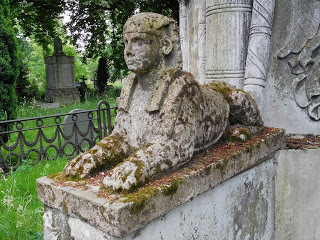
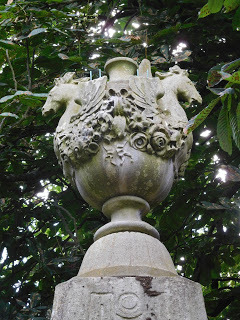
Published on June 18, 2017 21:30
June 17, 2017
Breakfast Links: Week of June 12, 2017
 Breakfast Links are served - our weekly round-up of fav links to other web sites, articles, blogs, and images via Twitter.
Breakfast Links are served - our weekly round-up of fav links to other web sites, articles, blogs, and images via Twitter.• Strong constitutions: that time when the Founding Fathers racked up a huge bar tab.
• The liberated wife who inspired Wonder Woman.
• Julia Grant's eyes: a love story.
• The etiquette of the Victorian ballroom: twenty tips for single gentleman.
• Stunning 1870 solar system quilt combines needlework and astronomy.
• Ah, the Enlightenment with Thomas Jefferson: when discussing how shells might have spontaneously appeared on land made more sense than geological time.
• Image: Colorful summer fashions via The Delineator, July 1915.
• The mother of all apples is disappearing.
• A color chart for woolen cloth from the early 18thc, including the delightful "Gall Stone Brown."
• Victorian Monopoly: from The Strand to Jail.
• An early 14thc wonder: the 53-ft tall bishop's throne canopy at Exeter Cathedral.
• The umbrella as a weapon (and why not?)
• Image: Swatches of Marie-Antoinette's dresses , preserved in the Archives Nationales.
• The feminist legacy of The Baby-Sitters Club.
• For decades inconvenient wives or relatives were committed to the Bloomingdale Lunatic Asylum .
• Before the garden gnome, there was the ornamental hermit .
• A 14thc garden of love and earthly delights in a flowery mead.
• For Poldark fans: explore the 18thc history behind the show.
• Image: Women's March , 17thc style: an army of women confront an army of monsters in this illustration from a 17thc pamphlet.
• Artist Mucha and his muse, pioneers of the Art Nouveau movement.
• A travel guide: the British tourist and Napoleonic Milan.
• From disinfectors to mush-fakers, photographs of real life on the streets of Victorian London .
Hungry for more? Follow us on Twitter @2nerdyhistgirls for fresh updates daily.
Above: At Breakfast by Laurits Andersen Ring. Private collection
Published on June 17, 2017 14:00



